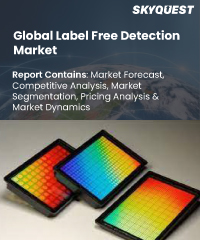
Report ID: SQMIG35I2221

Report ID:
SQMIG35I2221 |
Region:
Global |
Published Date: June, 2021
Pages:
242
|
Tables:
126 |
Figures:
77
Label Free Detection Market size was valued at USD 1.3 billion in 2022 and is poised to grow from USD 1.4 billion in 2023 to USD 2.5 billion by 2031, growing at a CAGR of 8.5% in the forecast period (2024-2031).
Integrated systems known as "label-free detection systems" are used to examine bimolecular interactions without the use of auto-fluorescence effects or labels. A quick and real-time approach to the discovery of new drugs is provided by these systems. Biochemical and cell-based assay detection are the most common applications for label-free detection.
The label-free detection market is being driven by a number of significant factors, one of which is the introduction of technologically advanced products. Over the period from 2021 to 2028, there will also be an increase in the number of academic-industrial partnerships supporting drug discovery programs, which will also contribute to the expansion of the global market.
The market expansion is also being aided by the rapid increase in funding for research and the high sensitivity of label-free technologies. One of the major contributors for the expansion of the label-free detection market is the expanding scope of pharmaceutical and biotechnology-related research and development activities. Over the forecast period, high industry growth will also be assured by the growing awareness among end-users about the benefits of using label-free detection methods.
US Label Free Detection Market is poised to grow at a sustainable CAGR for the next forecast year.
Our industry expert will work with you to provide you with customized data in a short amount of time.
REQUEST FREE CUSTOMIZATIONWant to customize this report? This report can be personalized according to your needs. Our analysts and industry experts will work directly with you to understand your requirements and provide you with customized data in a short amount of time. We offer $1000 worth of FREE customization at the time of purchase.

Report ID: SQMIG35I2221